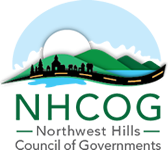On October 12th the Northwest Hills Council of Governments adopted a new Regional Plan of Conservation and Development. The Plan focuses on strategic actions that the Council of Governments can take along with its 21 member municipalities and other regional partner organizations to move the region forward in meeting its land use goals over the next ten years.
Based on survey results and feedback from 1,382 regional residents, 586 high school students, input from the planning and zoning commissions in the 21 member towns, and six focus group sessions, the Plan focuses on six regional goals:
- Attract and retain young residents
- Protect water quality and natural resources
- Support farm businesses and protect farmland
- Strengthen our town centers and Main Streets
- Meet the needs of our older adult residents and
- Continue to foster regional collaboration and resource sharing.
The Plan also contains three advisory regional policy maps and a Regional Recreational Trail Network Map. The Conservation Policy Maps show drinking water watersheds, riparian buffers, wetland soils, large contiguous forest habitats and prime farmland soils. The Sustainable Growth Policy Map shows areas that have access to public water, sewer, and/or public transportation as well as each town’s village/town center area.
The actions detailed in the Plan will guide the COG’s workplan and spur further collaboration with the region’s municipalities as well as its local and regional conservation, housing, and economic development organizations. The COG will be publishing an on-line toolkit that will assist its municipalities and partner organizations with implementing the Plan’s strategies.
Data, Analysis, and Feedback that Informed the Plan:
We received 1,382 responses from residents in our 21 member towns to our Regional Plan resident input survey. These responses helped identify the issues that are most important to our region’s residents and what our land use goals should be for the future. We used this information to determine priority strategies that should be carried out to achieve those goals together with our towns, regional non-profits, and residents. Over the next 10 years, NHCOG will assist our towns with carrying out these strategies and support our partner agencies in their work to meet these goals. To see the anonymous results of the survey, click here.
We held six focus group sessions to focus on what strategies should be included in our Plan:
- Local Food & Agriculture (June 30, 2016)
- click here for Working Lands Alliance list of strategies
- Housing (September 14, 2016)
- click here for housing data for the NHCOG’s 21 towns
- click here for housing strategies proposed by panelists
- Climate & Energy (September 29, 2016)
- Conservation & Recreation (November 30, 2016)
- click here for a summary of this focus group session and the proposed strategies
- Jobs & Vibrant Main Streets (January 30, 2017)
- click here for the PowerPoint slides from this forum
- click here for a list of economic development strategies proposed
We also collected and analyzed data on demographic, housing, and economic conditions and trends for each of our 21 towns and for the region as a whole. To view this data, click on the following links:
- Northwest Hills Regional Profile: Demographic, Economic, and Housing Data and Trends (October 2016)
- Demographic Data for our 21 towns (raw data in Excel spreadsheet)
- Analysis of demographic data (graphs in PowerPoint format)
- Economic Data for our 21 towns (raw data in Excel spreadsheet)
- Analysis of economic data (graphs in PowerPoint format)
- Housing Data for our 21 towns (raw data in Excel spreadsheet)
- Analysis of housing data (graphs in PowerPoint format)
